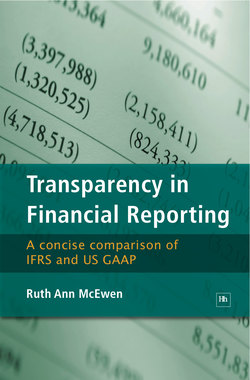Читать книгу Transparency in Financial Reporting - Ruth Ann McEwen - Страница 13
На сайте Литреса книга снята с продажи.
4. Fundamental Similarities and Differences
ОглавлениеThough standard setters have consistently worked to produce identical US GAAP and IFRS standards, fundamental differences still exist. For example, under IFRS, financial statements must meet the needs of a variety of users, including tax authorities. Under US GAAP, financial reporting must be useful to investors, creditors and others in predicting future cash flows. Since the US Tax Code can be at odds with financial reporting under US GAAP, tax authorities are not considered to be as important in US GAAP.
Both FASB and IASB are deeply involved in fair value measurement issues. In the 1990s, use of earnings per share as the most important indicator of corporate performance was associated with short-term earnings per share incentive managerial contracts, leading to short-term earnings maximization and earnings management, an unwanted and potentially illegal outcome. Under this system, the definition of assets and liabilities was not central to performance reporting. With adoption of IFRS and a fair value balance sheet, earnings and earnings per share may no longer lead performance indicators as the metric of choice in analyzing financial performance; instead, the statement of financial position and the statement of equity will be of the primary statements used to convey this information.
Differences between US GAAP and IFRS have also been caused by the codification project initiated by FASB in the early 2000s. Under US GAAP, guidance is either authoritative or not and as of July 1, 2009 the codification will be the sole source of authoritative literature. However, under IFRS, a hierarchy still exists, suggesting the ability for countries to carve-out sections of IFRS which they don’t intend to follow. Under the IFRS hierarchy, IFRS and related interpretations are considered to be the most authoritative guidance. If guidance is not directly applicable, managers are to use judgment in applying policy which will provide meaningful financial reports. If a standard does not exist for a specific transaction, preparers are told to look for alternative GAAP reporting requirements. Any GAAP with a comparable Conceptual Framework to IFRS will be allowed. Under this system, managerial manipulation would seem inevitable. The possibilities exist that entities in Canada, adopting IFRS in 2011, will encounter situations where IFRS does not offer guidance. In this circumstance, managers will be allowed to shop for guidance from GAAP alternatives, as long as these alternatives result from a conceptual framework comparable to IFRS.
The SEC has provided added incentive for the convergence of US GAAP and IFRS by allowing entities reporting under full IFRS to avoid costly 20-F reconciliations. Note that the SEC requires application of full IFRS, which does not allow carve-outs. In order to comply with this provision of SEC reporting, entities must be in compliance with IFRS as written, not as nationally revised. The following section provides a technical analysis of the current differences in US GAAP and IFRS and provides discussion concerning the potential carve-outs of convergence and their transparency effects.
